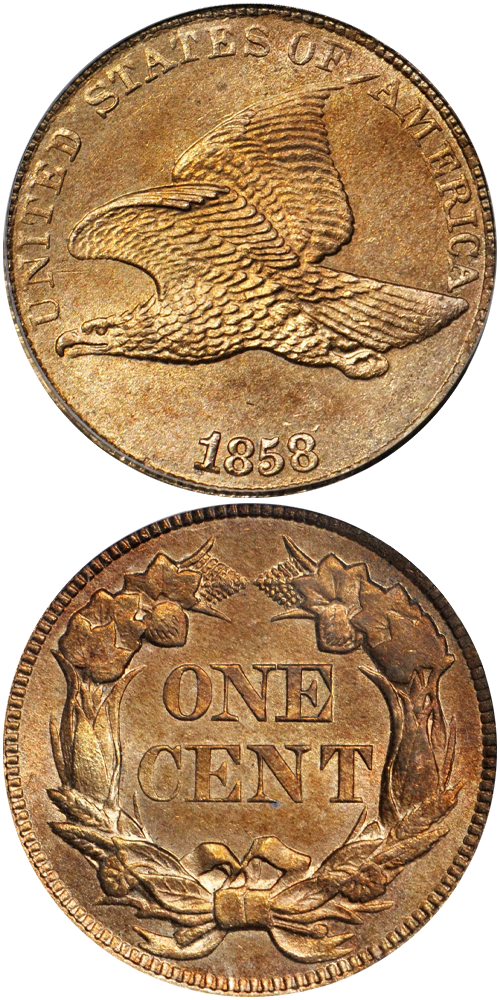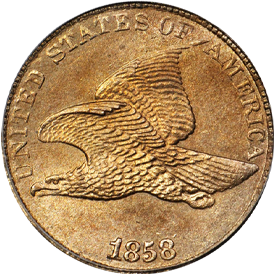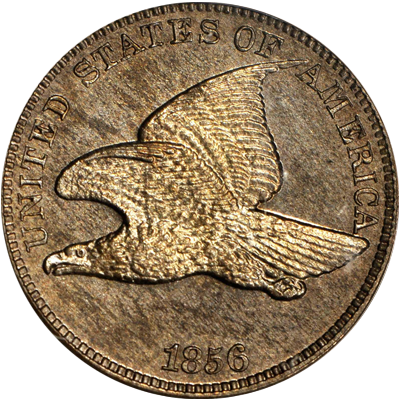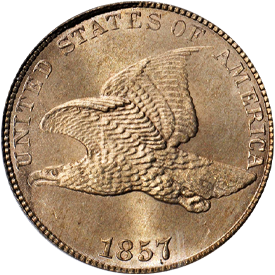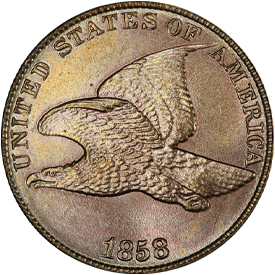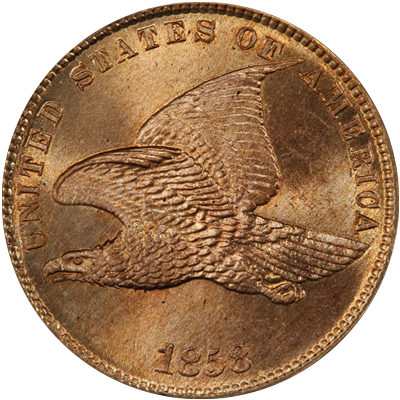Designed by: James Barton Longacre
Issue Dates: 1856 (pattern issue) - 1858
Composition: 88% copper, 12% nickel
Diameter: 19 mm
Weight: 4.66 grams (72 grains)
Edge: Plain
Business Strike Mintage: 42,050,000
To create the Flying Eagle cent, Mint engraver James B. Longacre borrowed two motifs from the past. The obverse employs an eagle in flight, borrowed from Christian Gobrecht's silver dollar patterns of the 1836-1839 years. Above is the inscription UNITED STATES OF AMERICA, while the date is below. The reverse displays a wreath of cotton, corn, wheat, and tobacco enclosing the word ONE CENT, the wreath itself having been used earlier on Longacre's designs for the $1 and $3 gold coins of 1854.
In 1856, approximately 600 pattern Flying Eagle cents were made for distribution to influential people to help secure approval of the design. Soon, the scarcity of the issue became known to collectors, and pieces were selling for $2 or more each (stated more sensationally, they were selling for 200 times face value). The Mint subsequently produced Proof restrikes to the extent of 1,000 or more coins, thus accounting for most Proof Flying Eagle cents known today (for relatively few Proofs were made in 1857 and 1858). In 1857, Flying Eagle cents were minted in large quantities for circulation. Coinage in large quantity for circulation continued through 1858. Trouble developed with the striking of the design, as often the head, upper wing tip, and tail of the eagle would be weakly impressed. As a result, the motif was discontinued.
For a type set, no difficulty will be encountered in the search for an 1857 or 1858 Flying Eagle cent in any grade from Fine through Extremely Fine. AU pieces are not difficult to find, and Uncirculated coins appear with some frequency. Truly superb Uncirculated pieces are rare.
Further Reading
Following the pattern cent issues of 1854 and 1855, patterns were prepared in 1856 for a small diameter cent, one with a really small diameter. These pieces are known today as 1856 Flying Eagle cents.
The Treasury Department believed that changing the cent format from the old large copper style was a necessity. However, as virtually every adult in America at the time had been accustomed to using large cents since childhood, an educational program was necessary. As a result, 1856 Flying Eagle cents, tiny in comparison to the large cents, were made in relatively large numbers for a pattern.
For many years the 1856 Flying Eagle cent has been one of the most desired of all United States coins. "Do you have an 1856 Flying Eagle cent?" was invariably a question asked of an experienced numismatist by a younger one when I first started collecting. That time, in 1953, was when everyone seemed to collect one example each of everything, a complete set of small cents, a complete set of nickel five-cent pieces, and so on. Today, of course, things are vastly different. No one can afford to collect one of each item. Also, the availability of coins simply isn't what it used to be. Given the needed money it would take much, much longer to find coins of comparable quality.
Nevertheless, the 1856 Flying Eagle cent, actually a pattern, remains a "key" piece in the Flying Eagle series. Information in the National Archives relates that slightly over 600 1856 Flying Eagle cents were obtained from the Mint in 1856 for distribution among congressmen and others in order to secure the adoption of the new small-size format. This procedure was not unlike that used in 1879 in an attempt to approve the $4 gold Stella. In all probability, the 1856 Flying Eagle cents known today in Uncirculated condition trace their ancestry to the original group of approximately 600 pieces. In addition, most worn specimens are original pieces that found their way into circulation.
Most Proof 1856 Flying Eagle cents known today are probably restrikes made in 1859-1860 and possibly for a few years after that time. The 1856 Flying Eagle cents occur in several minor die varieties, which can be logically explained by their issuance at different times. From the number known today I would estimate that somewhat more than 1,000 Proof 1856 Flying Eagle cents were coined. As most Proofs went to collectors, who paid a premium for them, whereas most Uncirculated original pieces did not go to collectors, the number of surviving Uncirculated specimens is much smaller than that of Proofs. Uncirculated examples are extremely rare and seldom offered for sale. However, when they do come on the market, they sell for less than Proof pieces, for Proofs traditionally have been regarded as "superior" to Uncirculated coins (although from a technical viewpoint Uncirculated and Proof coins represent different grades).
During the early part of the present century a number of individuals accumulated large quantities of 1856 Flying Eagle cents. The most famous of these hoards was a spectacular group of 531 pieces assembled by John Beck, a Pittsburgh, Pennsylvania collector. An inventory of these pieces made in 1931 by George Clapp revealed specimens in all grades. Beck was a hoarder par excellence, and vast quantities of commondate gold coins were found in his safe deposit box following his death. Many of these were simply cashed in for face value, but enough rarities remained that they formed the subject for several public auctions conducted by California dealers Jerry Cohen and Abner Kreisberg during the 1970s. At the same time these dealers distributed the 531 1856 Flying Eagle cents. It is reflective of the strength of the numismatic market that this spectacular sale, made over a period of several years, did not disturb the price of the pieces!
Today, little distinction is made between original 1856 Flying Eagle cents and restrikes. In fact, it is not generally known that any were restrikes. The point is possibly moot, for restriking was done near the year indicated. In past years little attention was paid to striking coins precisely for the years dated, and many similar examples are known. For instance, in the year 1879 only 15 examples of the 1879 Flowing Hair $4 gold were made. The reported mintage of 415 1879 Flowing Hair pieces refers to the 15 made in 1879 and 400 pieces (also dated 1879) which were struck in 1880. However, with one or two exceptions, I have never seen any differentiation made in print between "original" and "restrike" $4 specimens.
An article, "The 1856 Flying Eagle Cent," by John F. Jones, published in the April 1944 issue of The Numismatist, told of the pricing history of the issue. In 1859 specimens sold for $2, a high premium for a coin at the time. Undoubtedly this price, which can be more spectacularly stated by noting that it is two hundred times face value, served as an impetus for restriking, for $2 was a good day's pay! George W. Rice formed a hoard of 756 Flying Eagle cents of this date around the turn of the century, subsequently advertising them for sale in The Numismatist. Undoubtedly many of these pieces went en bloc to John Beck. While such hoards have staggering values today, it must be remembered that when they were collected the values were nominal. When Rice sold his pieces, average values were $10 or less for a coin.
The 1856 Flying Eagle cent has appreciated in value greatly over the years. By 1954 the price had risen to the $300 range. In that year Stack's held the Anderson-Dupont sale. I was beginning my efforts in the coin business, and a client had requested an 1856 Flying Eagle cent. I telephoned Harvey Stack in New York and asked him what one would cost me. He told me in a very apologetic tone that he would have to get "close to $310" for one, for that was what a specimen had just realized in his auction, and he had to pay close to that to obtain another one for his stock! The price, it turned out, was a bargain, for a decade later it was worth almost ten times morel
The 1856 Flying Eagle cents were struck as patterns. Like several other patterns, they have been "adopted" by collectors into the regular series, so few people consider them to be patterns anymore. Indeed, a set of Flying Eagle cents without an 1856 would be deemed incomplete by most observers. Many other pattern coins of the 1850s and 1860s are scarcer than the 1856 Flying Eagle cent. In fact, the 1856 Flying Eagle cent is by far the most common pattern one-cent piece ever made, but the demand for it has propelled it to the position of being one of the most expensive issues of its denomination, a seemingly illogical situation!
Following successful coinage of 1856 Flying Eagle cents, thoughts of legislators turned to abandoning the old large cent standard and adopting the small cent format. The Act of February 21, 1857 did exactly that, and the small cent was a legal reality.
This inspired a campaign to exchange old coins for new. Struck to the extent of more than 17 million pieces, 1857 Flying Eagle cents were distributed through banks. In the yard of the Philadelphia Mint a special booth was set up with a sign proclaiming that new cents were available for old ones and other coins. The 1857 Flying Eagle cents were put up in small cloth bags containing $5 face value (500 coins) each. Large cent redemption continued for many years, and as late as the mid-1870s over a million large cents were redeemed each year.
Cents of the year 1858 follow the same design as 1856 and 1857 and depict on the obverse an Eagle in flight facing left. UNITED STATES OF AMERICA is in an arc above, and the date is below. The reverse is an agricultural wreath composed of corn, wheat, cotton, and tobacco. The entire coin is a "copycat," for the features are not original. The Flying Eagle motif was designed by Christian Gobrecht and used on silver dollars two decades earlier. The wreath, the work of James B. Longacre, was earlier used on $1 and $3 pieces in 1854. The copper-nickel composition of the coins consisted of 88% copper and 12 % nickel. The nickel imparted a bright coloration to the alloy, with a result that these and copper-nickel Indian issues for years were referred to as "white cents." Flying Eagle cents of the 1858 year are differentiated by two main varieties, those with large letters on the obverse and those with small letters. An additional variety, the 1858/7 overdate, is also of interest. Unknown to numismatists for decades, the overdate first came to light in the 1950s. Since that time, it has received considerable publicity but still has remained scarce.
The Flying Eagle cents, coined for circulation only in 1857 and 1858, are one of the most ephemeral of all United States coin designs. Trouble developed with striking of the motif. The head and tail of the Eagle in particular would not strike sharply unless a special effort was made, as the heavy wreath on the reverse was opposite in the dies from these features, and the requirement that metal flow in quantity in both directions was not satisfactory. In 1858 a very extensive effort to develop a new design was undertaken.
Today, 1856 Flying Eagle cents exist to the extent of probably a thousand or more pieces, with the supply augmented in the 1970s by the dispersal of the Beck hoard. Proofs and impaired Proofs are the most readily available conditions, but worn pieces are seen occasionally, remnants from those distributed to congressmen and others of influence to secure the coinage legislation. Uncirculated coins, those surviving from the original striking of approximately 600 pieces, are rare.
Regular issue Flying Eagle cents of 1857 and 1858 are available in all grades from the lowest condition through Uncirculated. Proofs of the 1857 are quite rare, and probably only a few dozen exist. 1858 Proofs are known to the extent of a hundred or so pieces at most.
Numismatists desiring Flying Eagle cents usually want them for inclusion in a type set (in which instance just a single date, usually an 1857 or 1858, will suffice), or for part of a set of Flying Eagle and Indian cents (which are usually collected in combination with each other).
